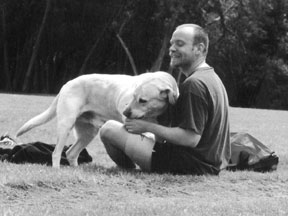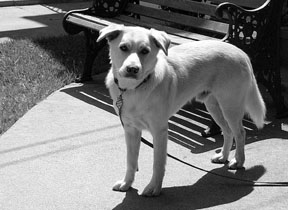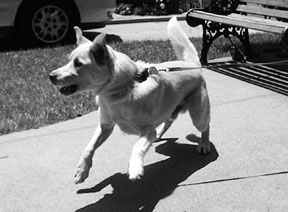Last month, author Lexiann Grant discussed the benefits of touching for dogs and humans (“Pet the Dog“). I was graphically reminded of those benefits recently when our beloved 15-year-old Pomeranian, Dusty, succumbed to an ulcerated cornea and eventual rupture of his left eye. This is an extremely painful condition, and given his failing ability to use his hind legs, refusal to eat, and signs of obvious depression, we sadly opted for euthanasia.
We spent our last afternoon together sitting in the sun, on the grass lawn of our new farm in Maryland. As I stroked Dusty’s soft golden fur and massaged his limbs and frame, I could see the tension leave his small, frail body. His pain seemed to fade at my touching; he stretched out on the grass with a sigh, more relaxed than he had been since his eye ruptured three days earlier. I could feel my own tension lessen as well, as I savored what I knew were my last moments with this gallant little boy who had shown me that small dogs could be every bit as big in heart and mind as their larger brothers.
I’m grateful that our dogs enjoy being touched, and that we can share the gifts that such healing contact offers. But not all dogs like – or even tolerate – being touched. Fortunately, a dog’s negative association with touching can often be changed through the use of counter-conditioning and desensitization (CC&D).
Classical v. Operant Conditioning in Dog Training
A negative reaction to being touched is usually a classically conditioned response. With classical conditioning, the environment acts on the dog. That is, the dog’s brain contains a pre-programmed message that says, “Touch is BAD!” – and when the dog feels your touch he reacts, without stopping to think. The negative message could be a result of harsh handling and punishment, pain from a prior injury, or simply a lack of adequate handling and socialization when he was a pup.
This is very different from operant conditioning, where the dog acts on the environment. For example, if you say, “Sit!” the dog thinks, “Ah, I know what that means – if I put my bottom on the ground I might get a cookie!” and so he chooses to sit in order to make a good thing happen. When your dog reacts to your touch with distaste, perhaps even aggression, he’s not choosing to react that way, it just happens, thanks to that pre-programmed message in his brain.

The most effective and successful way to change your dog’s response to your touch is through counter-conditioning, which reprograms the message at a low level of stimulus that he can at least tolerate – perhaps briefly and softly touching his head. Then we use desensitization to help him accept the touching at gradually increasing levels of intensity – touching more of his body, or touching with more pressure, or for longer periods of time.
It’s almost magical to watch an effective CC&D program in progress. Some behavior changes I’ve seen as a result of this kind of behavior modification have been nothing short of miraculous, such as one family’s Chow mix and newly adopted Chow who wanted to tear each other to shreds, but became fast friends within three weeks when the owners implemented a CC&D program.
Reprogramming Touch Sensitivity in Dogs
Perhaps your dog will tolerate a light touch on the top of his head, and a gentle scratch under his chin, but he becomes very tense if you do more than that, and any efforts to touch his legs and feet or his hindquarters and tail elicit serious warnings about forthcoming aggression. You believe him, and wisely don’t press the issue, but that means even simple but necessary procedures such as nail trimmings and baths are stressful and potentially dangerous.
The first step in your program is to have a complete and thorough veterinary exam, and an adjunct visit to a chiropractor if indicated. Pain is a huge contributor to aggression – if he’s hurting, all the CC&D in the world won’t change his opinion of being touched – it hurts!
Of course, if the whole point is that your dog doesn’t tolerate being touched, how do make him submit to a vet exam before you work on the problem?
Unfortuntely, it’s a necessary evil, so spend a week (or a few weeks) acclimating your dog to a comfortable cloth muzzle. Lend muzzle-wearing a very positive association by pairing its presence and application with wonderful treats. Then muzzle him before the vet or vet tech begins to examine him, in order to keep everyone safe.
Ask your whether using a sedative would help make the experience less traumatic. You might also consider products such as herbal calming agents, Rescue Remedy, and DAP (Dog Appeasing Pheremones, sold as “Comfort Zone“).
With a clean bill of health, you’re ready to begin. You’ll need a large supply of absolutely scrumptious treats – canned chicken, rinsed and drained, is my favorite for CC&D purposes; most dogs totally love it. Pick a comfortable spot on a bed that your dog loves, or lay down a cushion or a soft thick blanket for the two of you to sit on. Attach a leash to your dog’s collar so you don’t have to grab to keep him with you.
The sequence of the next part is very important. You will touch your dog’s head first, very briefly – say for one second – then feed him a tiny bit of chicken. The touch must come first because you want him to understand that the touch makes the chicken happen. If you feed chicken first, then touch, he won’t make that connection.
Keep repeating this step until your touch causes him to look at you with a smiling face as if he’s saying, “Alright – you touched me. Yay! Where’s My Chicken?” You want the “Where’s My Chicken?” (WMC?) response to happen reliably several times in a row before you proceed to the next step.
Good job! You’ve accomplished the first tiny step on a long road; he thinks being touched softly and briefly on the head is a wonderful thing. Now you must decide whether to stop the session – ending on a high note – or continue on because you both are having a wonderful time and don’t want the session to end. If you’re unsure how much longer he will work with you, it’s better to stop sooner, while you’re ahead, than to push it too far and suffer a setback.
If you proceed, the next step might be to touch him on the head, still very gently, but for two seconds. You may lose the WMC? response at first as he adjusts to the increased time, but it will probably return quickly. Continue to increase the time, very gradually, so you don’t lose the progress you’ve made. As your touches get longer, feed him several treats in rapid succession while you are touching. Remember to stop the treats when the touch stops.
Be sure to end the session before one or both of you gets bored, tired, stressed, or frustrated. You can always do another session later that day or the next. If you sense that he’s getting restless, stop the session, feed him a few extra tidbits for being a wonderful boy, and release him with an “All done!” cue. Next time, stop a little sooner – you don’t even want him to think about getting restless.
Session #2 – Taking the Next Step

When you start up again with your next session, back up a little. If you ended with five-second gentle touches on your dog’s head, start with three-second touches. You’ll be able to progress more quickly back up to five seconds, but be sure to start within his comfort level and warm up to the place where you ended.
When he has a positive association with gentle touching up to perhaps 10 seconds, you can increase the intensity of a different stimulus – the amount of pressure. Each time you raise the bar for a new stimulus, lower it for the others – in this case you might go back to two or three seconds, with a slightly stronger pressure when you touch. Work to get that positive “Where’s My Chicken?” response with the new amount of pressure at each length of time before you increase the time again.
When he’s responding happily to a moderate amount of touch pressure at 10-15 seconds, you can increase the intensity of the third stimulus in the touch package – the position of your hand. Up until now you’ve been touching him in his most accepting spot – the top of his head. Now you’re going to begin to move your hand to more sensitive places – again reducing the intensity of the other two stimuli – time and pressure.
Perhaps you’ll try ears first. Returning to a very gentle touch, stroke one ear for one to two seconds, then feed some chicken. Repeat this until you’re getting his WMC? response to the ear-stroking, then do the same with the other ear. Gradually increase the length of time you stroke each ear gently, and when you’re getting positive responses to 10-second ear stroking, it’s time to increase the pressure. Shorten your ear strokes back to one to three seconds, but stroke the ear a bit more firmly.
Remember to be very generous with your chicken bits, feeding a morsel or two every time you stroke the ear, and several morsels as the touches get longer. When he’s happy to have you stroke both ears firmly for 10-15 seconds or longer, you can move to a new spot.
Don’t forget to reduce the other stimuli each time you move to a new touching place. After the ears, you might run your hand down the back of his neck, gently and briefly. Treat! You should find that as you work toward various new spots around your dog’s legs and body, he’ll accept new touches more quickly in many places. Adjust your pace to his behavior. If he’s giving you WMC? responses very quickly, you can progress more rapidly in your program. If he seems slower to respond, you’re probably working on or near a very sensitive place, and you need to slow the program down. He’ll tell you how slowly or quickly you can progress. Listen to him. Attempts to force him to accept your touching will backfire, big-time.
Petting Sensitive Spots
Many dogs, even those who are comfortable being touched elsewhere, are tense about having their feet handled. Take extra care as you begin to move down his legs. A few extra days – or weeks – now will pay you jackpots in the long run, when you can finally clip his nails without a violent struggle. Spend lots of time massaging the areas where your dog has come to enjoy being touched, and occasionally work on the more sensitive spots. In addition to the chicken, soothing massage sends a very positive association to the message that you are reprogramming in his brain.
It’s critically important to avoid triggering the negative associations outside your CC&D sessions. If you forget about his sensitivities and grab him during a “real-life” moment you may set your program back. It won’t hurt to skip one or two nail-trimming sessions while you work to get him to accept foot-handling without a fight.
Make sure that others are aware of the importance of respecting your CC&D program too. There’s nothing like having a friend or family member think it’s funny to see your dog’s negative reaction when they play “grab your paws” – thereby undoing all the good work you’ve done. Grrrr! I’ve been known to banish human acquaintances from my household for less!
Factors for Ease of Touch Conditioning
How quickly you complete your CC&D program depends on several factors:
• Your dog’s age, and how long he has been displaying a negative response to being touched.
• The intensity of his negative association with touch.
• The cause of his sensitivity. Prior harsh handling is likely to be more difficult to overcome than lack of handling, since he has a negative association with the human presence as well as the sensitivity to touch itself.

• Status of physical contributors to the sensitivity. If your dog has a grass allergy that causes inflammation in his pads, for example, your constant struggle to reduce the discomfort in his feet will slow your CC&D progress.
• Your commitment to implementing the program on a daily basis. Several short sessions a day are generally more effective than one long daily session.
• Your skill at reading your dog’s comfort level and moving the program forward at an appropriate pace without triggering negative reactions.
Success!
The success rate for touch CC&D programs is high. Unlike modification programs for things like dog reactivity, where it’s difficult to control all the variables, you can manage the factors of a touch modification program with relative ease. Chances are good that even if you don’t achieve 100 percent positive association with touching every part of your dog’s body, you can accomplish a positive response for much of it, with agreeable acceptance for the highly sensitive parts.
Just ask our three-year-old Scottish Terrier. When we found him as a stray in Chattanooga as a six-month-old pup, his feet were raw and bloody, he had sores and scabs all over his body from a generalized dermatitis, and his ears were badly infected, all from a severe grass allergy – not uncommon to Scotties. He could barely tolerate being brushed, treating those infected ears was a real challenge, and touching his sore paws was out of the question.
Today, although he’s still a little sensitive about his paws, he adores being touched elsewhere – there’s nothing he loves more than lying on my lap, stretched out flat on his back for tummy rubs, and having the rest of his body brushed and massaged. We’re still working on feet – it was 18 months before I could clip all his nails in one sitting – and his first instinct is to pull away when I touch them – but then he relaxes and enjoys a little foot massage as well.
And for me – there’s nothing like a Scotty body in my lap to help ease the tensions of a busy day, and soften the grief of losing a beloved companion.
Pat Miller, CPDT, is WDJ‘s Training Editor. She is also author of The Power of Positive Dog Training, and Positive Perspectives: Love Your Dog, Train Your Dog.






Hi Pat,
At 6 months, within a week of his last vaccination, my dog became aggressive if touched anywhere. He will attack without warning if you so much as put a hand out towards him. Up until this point he cuddled often and enjoyed being touched. Now I am the only person he will tolerate in his space and he growls at anyone else near his kennel. On walks he is nonchalant when people approach nor does he attempt to lunge/chase people of any age. He seems to be extremely territorial/possessive and that includes his body.
He was raised in a family home, taken on family outings and heavily socialized. Never was a hand raised against him. I put my heart and soul into him.
He was checked out by the vet multiple times (bloodwork included) and confirmed to be perfectly healthy.
Unfortunately he is also extremely food aggressive, something I have worked to desensitize him to since he was 4 months old to no avail. I mention that because if you have food in your hand or he even smells it near and you attempt to pet him, it will be on in a flash.
However you can ask him to shake and he will gladly let you hold his paw in return for a treat.
He has bit me his owner (the man who spends at least 1 hour per day exercising/training him) and even bit the highly-respected behaviorist I hired for attempting to gently pet him after a good training session.
Please advise how to help a dog like this?
Prozac? They do use it in dogs
I need help with an extremely fearful dog. She’s a maltese named Phoebe. She has been with me for 4 months after being rescued from a puppy mill (she was a breeder all her life and now at 6 she gets to start enjoying life). I’ve been patient, giving her space, waiting for her to come to me. She seems interested in what I’m doing sometimes but the moment i make any movement, whether toward her or not she scurries away. I have tried to toss a treat toward her anytime I move but it seems she is not extremely interested in treats, sometimes she likes cheese but not enough to go for it if she sees me looking at her, or holding the cheese. I’ve tried getting her to come a little bit closer and closer to get the cheese but it seems her fear threshold is still very very low. At some point the cheese just isn’t worth it if it’s too close to me.
Anytime I try to take a step closer to her she goes running under the bed to hide. I don’t want to follow her to the one place she feels safe by reaching toward her under the bed. She’s small and her hair is getting so long she can’t see anymore which I imagine isn’t helping with her fear. I haven’t been able to get her to the vet, put a collar on her, a leash. Nothing. I feel like progress is stalling. Please help.
Lauren and Phoebe-
Your dog has had an extreme non normal social life, you may want to consider adopting another dog that is confident, and playful who she may feel safe to bond with, to help her feel more secure. But I don’t think she can ever lose her fear of humans.
FYI, I am just an experienced dog owner of 50 years, not a trained dog expert. While a dog obviously is not a human but any animal that has been caged for 6 years and used as a breeder is damaged mentally and honestly may never lose her fear or ever feel very safe around humans. I have owned 4 adopted dogs all around 2 years old when i got them (throughout the years). 3 were very happy to have a new home with me. The one i still have is very fearful.
I have no history on her but she was 10 lbs underweight when i got her…skin and bones. 27 lbs then and is now 38 lbs. It took her 4-6 months before she would take the initiative to sit near me as i work on my computer or hang out where i was. She will only tolerate brief petting, before she runs away scared. She is gentle, not aggressive, and will follow instructions IF she knows she can’t run away. She was housebroken from the beginning and loves to be outside. I have owned her now for 10 years and her personality has not changed.
To leash her or give her any medications or to trim her nails, i have to make sure she is inside the house with no way to escape, then she submits to whatever i need to do to her. I firmly tell her to sit and she will cooperate, but she is still scared and shaking.
Right now she is under my desk snoozing, but if i try to pet her even briefly, it would stress her, so i giver her no touch space and let her feel safe but with minimal touch contact. I know she is happy with me, trusts me, misses me when i leave the house and excited when i return, but she will never be a cuddly pet. I can see she does not know how to play with humans, but does like playing with dog friends. I have a 2nd dog with her, a very fun, sweet dog who she like a lot, I know it helps her feel more secure seeing my other dog is at ease and can be her buddy.